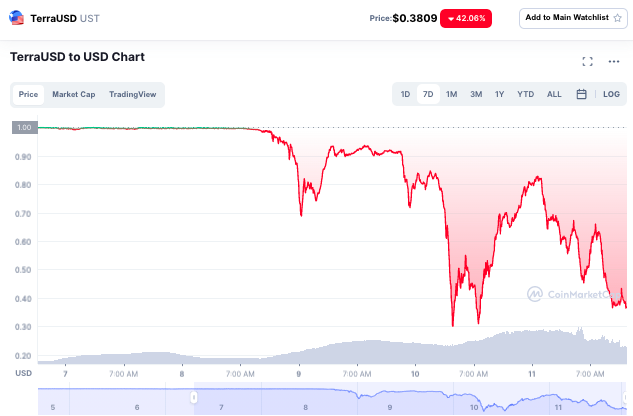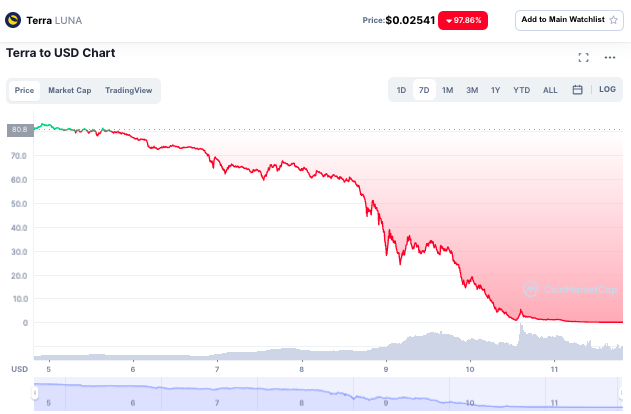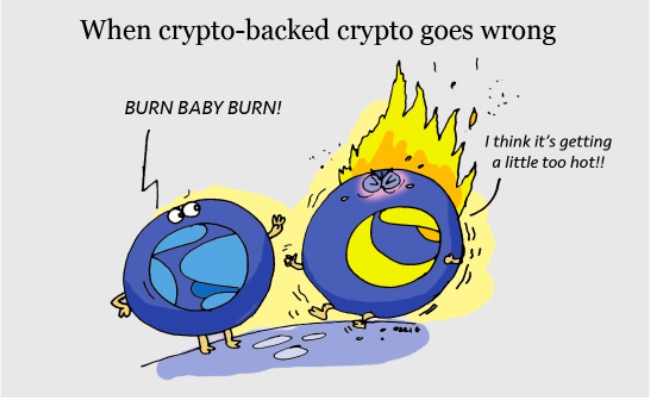- TerraUSD (UST) lost 1:1 peg with $USD.
- The Luna Foundation Guard (LFG) sold billions in Bitcoin in attempt to defend peg.
- The selloff in Bitcoin by the LFG precipitated wider crypto market crash which made problem worse.
- The only way this could have worked is if the Luna Foundation Guard had enough liquid funds to absorb the entire selling supply of UST that initiated the cycle.
TerraUSD (UST) lost it’s one-to-one peg with the US dollar beginning May 5, 2022 causing a chain reaction as the Bitcoin reserve used to hold the 1-to-1 peg was force-sold in the market. This in turn drove down the price of Bitcoin which affects the price of every crypto currency since it is used as the reference asset for the crypto market.
Terra is an algorithmic stablecoin platform whose two primary coins of note are:
- TerraUSD (ticker: UST)
- Terra (ticker: LUNA)
Traditional stable coins, such as Tether, are designed to hold $1 USD for every $1 digital coin. When demand for Tether is high (people want to buy Tether and pay in US dollars), then new Tether coins are minted and cash is deposited into Tether’s treasury. For every new coin minted, a new US dollar is deposited. When supply for Tether is high (people want to sell Tether and receive US dollars), then Tether can be burned and US dollars withdrawn from the treasury.
Algorithmic stable coins such as UST, operate on a different principle that at its core requires decentralized trust and widespread use of UST. When demand for UST is high (people are buying UST and pushing its price over $1 USD), then new UST is minted through “burning” the LUNA coin, which increases the supply of UST and decreases the supply of LUNA. When supply for UST is high (people are selling UST for less than $1 USD), then UST is “burned” and new LUNA is minted, which decreases the supply of UST and increases the supply of LUNA.
The minting and burning is all done by arbitragers reacting to the over or under supply of UST in the marketplace. When the arbitragers see UST trading at $1.01 or higher, they get to work by swapping $1 worth of LUNA for 1 UST. They then take that UST and sell it on the market for $1.01. This makes them a 1% return in a matter of minutes. This is a very good return and a great incentive. Just think, if someone is looking to buy 1,000,000 UST at $1.01, for $1,010,000 and the arbitrager can buy UST at $1.00 for a flat $1million, they can make $10,000 in a very short amount of time.
Similarly, when arbitragers see UST trading at $0.99 or lower, they can purchase 1 UST token in the market for $0.99 and then use the Terra platform to swap that for $1 worth of LUNA and then go and sell that LUNA in the market for $1.00, again making 1% return.
This should work, right? Supply and Demand and all that?
Well, what happens when you have many people wanting to sell UST all at the same time? The supply of LUNA is going to skyrocket as the arbitragers rush in to defend the UST peg by buying massive amounts of UST (from the large group of unexpected sellers) and swapping those for LUNA which mints new LUNA and burns the swapped UST. This will reduce the price of LUNA now that there are many more LUNA tokens in circulation. If the supply of LUNA is increased by a significant amount, then a corresponding significant price drop can occur, ultimately approaching $0.


As the price of LUNA drops, there will be a point where there are simply no buyers of LUNA left in the market, which means there is nobody for the arbitragers to sell to, which means there is no arbitrage activity, which means there is no way to defend the UST peg algorithmically.
It looks like this scenario unfolded this week, and in an effort to defend the UST:USD peg, LUNA was artificially propped up by the LUNA Foundation Guard which had a treasury of some $4.5 billion in Bitcoin that they partially liquidated in order to generate funds with which to buy LUNA from the arbitragers.
So, in short:
- In order to defend the UST peg, the arbitragers needed buyers of LUNA.
- The LFG sold billions worth of Bitcoin to fund purchases of LUNA from the arbitragers.
- The LFG Bitcoin selloff drove down the whole crypto market, generating a vicious cycle.
- The only way this could have worked is if the LFG had enough liquid funds available to purchase all the LUNA needed to satisfy the arbitrage requirements of the market during the original selloff of UST.

2 thoughts on “Everything You Need to Know About the Terra/Luna Stablecoin Crypto Crash”